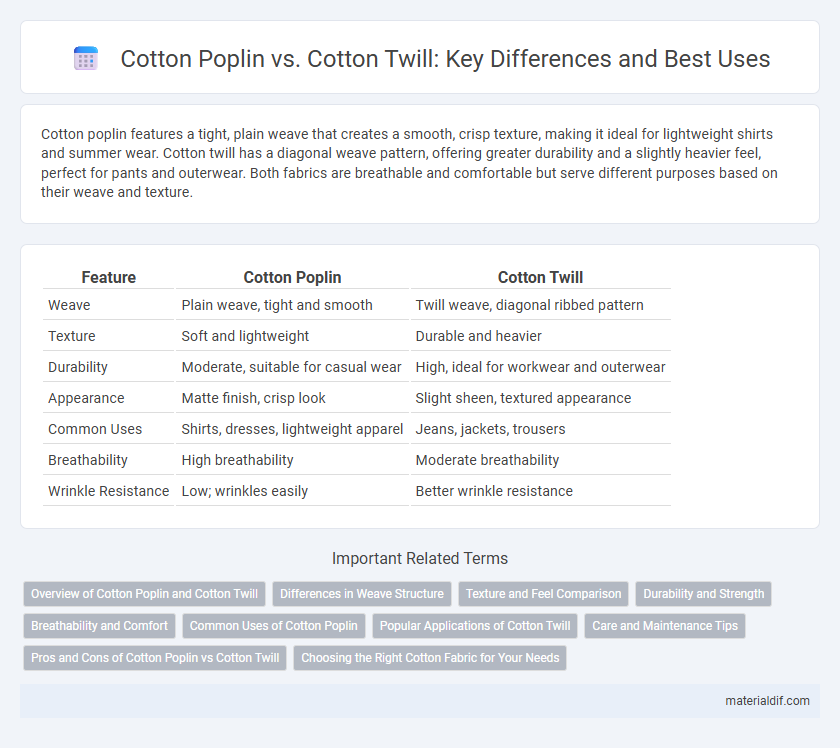Cotton poplin features a tight, plain weave that creates a smooth, crisp texture, making it ideal for lightweight shirts and summer wear. Cotton twill has a diagonal weave pattern, offering greater durability and a slightly heavier feel, perfect for pants and outerwear. Both fabrics are breathable and comfortable but serve different purposes based on their weave and texture.
Table of Comparison
| Feature | Cotton Poplin | Cotton Twill |
|---|---|---|
| Weave | Plain weave, tight and smooth | Twill weave, diagonal ribbed pattern |
| Texture | Soft and lightweight | Durable and heavier |
| Durability | Moderate, suitable for casual wear | High, ideal for workwear and outerwear |
| Appearance | Matte finish, crisp look | Slight sheen, textured appearance |
| Common Uses | Shirts, dresses, lightweight apparel | Jeans, jackets, trousers |
| Breathability | High breathability | Moderate breathability |
| Wrinkle Resistance | Low; wrinkles easily | Better wrinkle resistance |
Overview of Cotton Poplin and Cotton Twill
Cotton Poplin is a lightweight, tightly woven fabric with a smooth texture, commonly used for shirts and dresses due to its crisp finish and breathable properties. Cotton Twill features a distinctive diagonal weave, making it more durable and resistant to wrinkles, often utilized in trousers, jackets, and workwear. Both fabrics are made from cotton fibers but differ significantly in texture, weight, and typical applications, with poplin offering a sleek appearance and twill providing strength and durability.
Differences in Weave Structure
Cotton Poplin features a plain weave with tightly woven, fine yarns that create a smooth, crisp texture ideal for lightweight garments. In contrast, Cotton Twill employs a diagonal weave pattern, resulting in a sturdier fabric with enhanced durability and distinct diagonal ribs. The weave structure differences influence fabric weight, breathability, and drape, making Poplin suitable for shirts and blouses, while Twill is preferred for heavier apparel like jackets and trousers.
Texture and Feel Comparison
Cotton poplin features a smooth, lightweight texture with a crisp finish, making it ideal for breathable, soft garments like shirts and dresses. Cotton twill presents a denser weave with a diagonal rib pattern, creating a sturdier, more durable fabric that feels thicker and slightly heavier. The tactile contrast between poplin's fine, smooth surface and twill's textured, rugged feel influences their suitability for different apparel and uses.
Durability and Strength
Cotton twill features a distinctive diagonal weave that enhances its durability and strength, making it highly resistant to wear and tear compared to cotton poplin. While cotton poplin has a smooth, plain weave that is lightweight and breathable, it lacks the robustness found in twill fabrics. For applications requiring long-lasting performance and resilience, cotton twill is the preferred choice due to its sturdier construction and superior tensile strength.
Breathability and Comfort
Cotton Poplin offers exceptional breathability due to its lightweight, plain weave structure, making it ideal for hot and humid climates. In contrast, Cotton Twill features a denser, diagonal weave that provides enhanced durability but slightly reduced airflow, which can affect comfort in warmer conditions. Both fabrics prioritize comfort, but Poplin excels in moisture-wicking and ventilation, while Twill is better suited for cooler environments requiring sturdiness.
Common Uses of Cotton Poplin
Cotton poplin is frequently used in making lightweight shirts, dresses, and blouses due to its smooth texture and breathable qualities, making it ideal for warm weather clothing. It also finds applications in uniforms, children's wear, and home textiles like bedsheets because of its durability and easy maintenance. The fine, tight weave of cotton poplin provides a crisp finish that is favored in both casual and formal apparel.
Popular Applications of Cotton Twill
Cotton Twill is widely favored in the fashion and upholstery industries due to its durability and distinctive diagonal weave, making it ideal for durable garments like jeans, chinos, and workwear. Its strength and resistance to wrinkles also make it a preferred fabric for home furnishings such as curtains, slipcovers, and cushions. This robust textile offers both functional and aesthetic benefits that enhance the longevity and appeal of everyday items.
Care and Maintenance Tips
Cotton poplin requires gentle washing in cold water to maintain its smooth texture and prevent shrinking, while cotton twill benefits from warmer water washes and occasional steam ironing to preserve its durability and diagonal weave. Avoid bleach on both fabrics to prevent fiber damage and color fading, and air drying is preferred to maintain fabric integrity. Regularly checking care labels ensures appropriate detergent choice and washing methods tailored to each fabric's fiber density and weave structure.
Pros and Cons of Cotton Poplin vs Cotton Twill
Cotton Poplin features a fine, tight weave that offers a smooth, lightweight, and breathable fabric ideal for shirts and summer apparel, but it tends to wrinkle easily and lacks durability under heavy wear. Cotton Twill is known for its distinctive diagonal weave, providing greater durability, wrinkle resistance, and a heavier weight suitable for pants and jackets, although it is less breathable and can feel stiffer than poplin. Choosing between cotton poplin and cotton twill depends on the intended use, with poplin excelling in comfort and breathability, and twill excelling in strength and longevity.
Choosing the Right Cotton Fabric for Your Needs
Cotton Poplin offers a smooth, lightweight texture ideal for breathable summer clothing and crisp shirts, while Cotton Twill features a distinctive diagonal weave providing durability and resistance to wrinkles, making it perfect for workwear and outerwear. When choosing the right cotton fabric, consider whether you need softness and breathability for comfort or strength and structure for longevity. Evaluating the fabric's weight, weave, and intended use ensures you select the cotton material that best suits your specific garment requirements.
Cotton Poplin vs Cotton Twill Infographic

 materialdif.com
materialdif.com